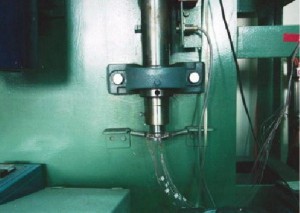燃氣輪機引擎(Gas Turbine Engine)為一般動力系統的動力來源,在工業發展及國防科技上一直扮演著極為重要的角色。在不斷提高工作效率的要求下,燃氣溫度相對地提高,使得葉片容易被高溫流体所破壞,因此,過去數十年來,許多學者紛紛投入葉片冷卻(Blade Cooling)的研究,在幾種冷卻方式中,以衝擊冷卻(Impingement Cooling)的效率最好,但是,在動態量測技術的困難影響下,已發表的文獻中,旋轉狀態的模擬研究十分有限,基於此,本研究室在多年前即設計出可於旋轉狀態下,進行實体模擬研究之測試系統(如圖所示),此一測試系統,可於旋轉狀態下,透過滑環(Slider),同步擷取相關測試數據,以了解旋轉對於衝擊冷卻的影響(請見摘要),提供設計者作為參考。
針對燃氣輪機葉片受高溫流体衝擊的解決之道,現今大致上採用以下三種冷卻方式:
- 薄膜冷卻 (Film Cooling):在葉片行凹面或凸面挖噴射孔,由內部排出冷空氣進行冷卻。
- 衝擊冷卻 (Impingement Cooling):利用冷流體,以高速的方式直接衝擊發熱的固體表面,以強烈的對流作用,迅速將熱量帶走。
- 內部冷卻 (Internal Cooling):在葉片縱面挖方形、三角形或圓形通道,利用冷卻空氣流經通道內部時,將熱量帶走。
Local Heat Transfer in a Rotating Square Channel With Jet Impingement
| Author Source Abstract |
S. S. Hsieh, J. T. Huang and C. F. Liu Journal of Heat Transfer, Transactions ASME v.121 n.4 Nov. 1999 pp. 811-818 The influence of rotation and jet mass flow rate on the local heat transfer coefficient for a single confined impinging round jet with a fixed jet-to-wall spacing of H/d=5 was studied for the jet Reynolds number from 6500 to 26000 and the rotational Reynolds number from 0 to 112,000. The local heat transfer coefficient along the surface is measured and the effect of the rotation on the stagnation (peak) point, local and average Nusselt number, is presented and discussed. Furthermore, a correlation was developed for the average Nusselt number in terms of the parameters of Rej and ReΩ. In general, the combined jet impingement and rotation effect are shown to affect the heat transfer response. Rotation decreases the average Nusselt number values from 15 to 25 percent in outward and inward radial flow, respectively. Finally, comparisons of the present data with existing results for multijets with rotation were also made. |
